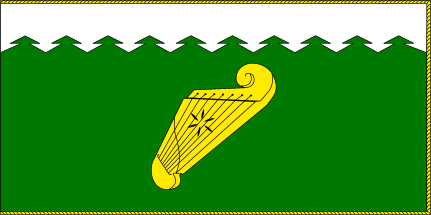
by Audrius Slapsinskas, 24 June 2003

Last modified: 2003-07-05 by dov gutterman
Keywords: lithuania | siauliai | raudenai |
Links: FOTW homepage |
search |
disclaimer and copyright |
write us |
mirrors

by Audrius Slapsinskas, 24 June 2003
See also:
The flag and coat of arms of Raudenai were drawn according to
pictures, which was taken from booklet: DISTRICT OF SIAULIAI
AND ITS CONTEMPORARY HERALDRY [lal02].
Here is information from this book:
"Raudenai - During the times of the Grand Dutchy of
Lithuania Raudenai was a branch of the Dirvonenai minor Ducal
estate. In the act of 1611 Sigismundus Vasa calls it "villa
nostra" (our estate). The growth of the settlement is
closely linked with the estate, which was owned by B. Berdovskis
at that time. Under his initiative the church of St. Balthasar
the Apostle was built in 1611. As there were only a few
Lithuanian priests the parishes of Raudenai and Tryskiai were
administered jointly. In 1622 the parish of Raudenai expanded its
rights and territory with the permit by King Sigismundus Vasa.
In 1739 a new church was built, but the present wooden church in
the construction from 1881 and with a valuable collection of
paintings and wood carvings from the 18 di century stands.
The number of the population in Raudenai grew from 273 in 1859 to
406 in 1986.
Raudenai is located 14 km to the west from Kursenai on the left
bank of the river Rauda. Being 40 km from Siauliai it was the
home town of such outstanding figures as K. Pakalniskis, V.
Telksnys-Lankaitis and others.
Raudenai never had a coat of arms so it was agreed to depict the
Lithuanian national musical instrument kankles, much attention to
which was given in the 16 th century by J. Bretkunas, T.
Lepneris, K. Donelaitis, S. Daukantas and others. Many museums
exhibit kankles of the 18th-19th century. Folklore expeditions
have collected sayings that kankles of the highest quality are
made from a tree cut on funeral days. The symbol of kankles has
been chosen because of the name of the river that crosses the
settlement. St. Cecyl, patroness of music in the Lithuanian
folklore, is often depicted with kankles in her hands.
The coat of arms depicts the golden kankles on the upper field of
the shield. The shield is divided into two fields - of green and
silver, the devision is marked by a row of fir trees (design by
Laima Ramoniene).
The Raudenai coat of arms was confirmed by the President of the
Republic of Lithuania on March 24, 2000."
Audrius Slapsinskas, 24 June 2003
sasar.gif)
by Audrius Slapsinskas, 24 June 2003